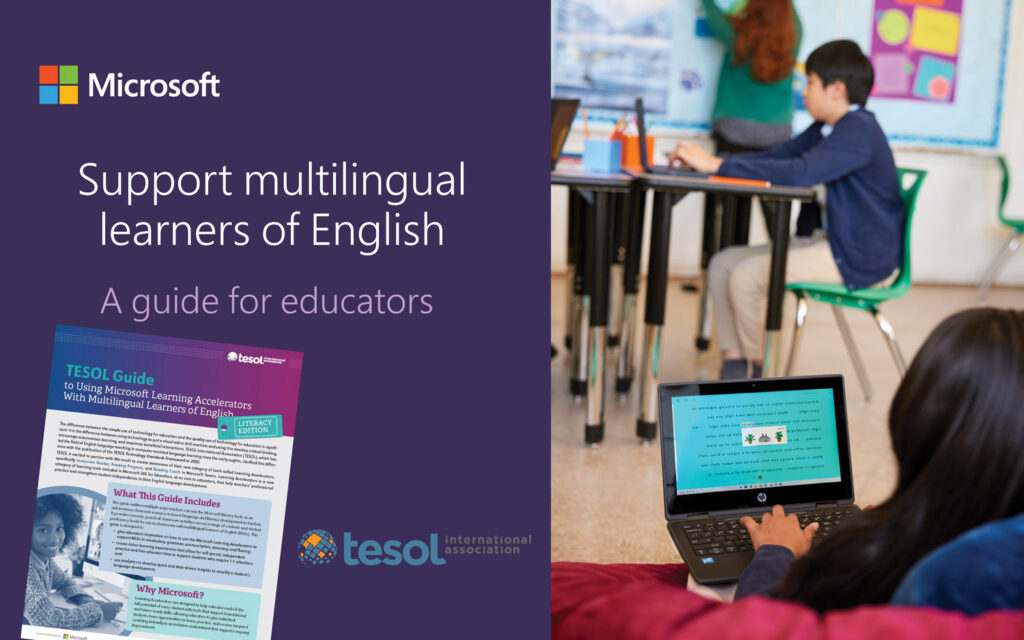At least 350 languages are spoken in the U.S. and, according to the National Education Association, by 2025, 1 out of 4 children in U.S. classrooms will be a multilingual learner of English (MLE). Microsoft and Teachers of English to Speakers of Other Languages (TESOL) have joined together to help you meet the needs of all MLEs in your classroom by providing valuable activities that strengthen language development using Microsoft’s Learning Accelerators. The guide provides concrete, practical classroom activities across a range of contexts and student proficiency levels for use in classrooms across Elementary, Secondary, Adult, Teacher Training for MLEs who are beginner, intermediate, or advanced.
Learning Accelerators in Microsoft Teams for Education can help enhance language and literacy instruction and strengthen student independence in English language development. Immersive Reader, Reading Progress, Reading Coach, and Education Insights are four solutions you can use in your classroom to support all students’ reading, writing, listening, and speaking skills. Explore how each of these solutions can provide differentiated, individualized support for MLEs.
1. Support fluency with Reading Progress
Reading Progress frees up your time by streamlining the process for creating, reviewing, and analyzing individualized reading assignments. This solution can be used to support and track your students’ reading fluency. Students record their reading while their errors, accuracy rate, and correct words per minute are automatically analyzed. Learn more about how you can use Reading Progress to support the needs of MLEs.
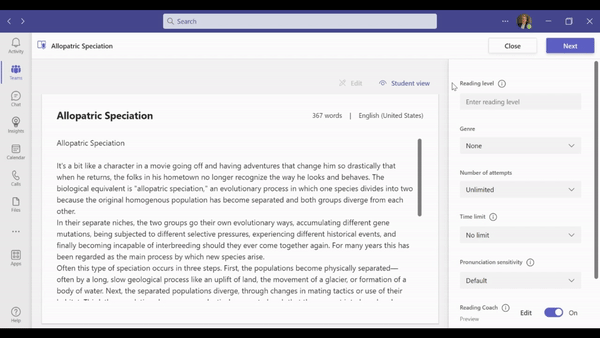
Pronunciation sensitivity adjustment in Reading Progress in Microsoft Teams for Education.
- Adjust pronunciation sensitivity: To account for different speech patterns and accents when students read aloud, adjust how carefully pronunciation sensitivity in the Auto-detect feature analyzes results to make your review faster and more accurate. This feature predicts and marks mispronunciations, omissions, insertions, self-corrections, and repetitions. You can also manually edit errors for accuracy or turn off the Auto-detect feature.
- Chunk text: Use Reading Progress to break text into manageable sections which can help improve student confidence when reading in English. To do this, copy and paste (or transcribe) the assigned reading in Microsoft Word, creating a new document at an appropriate cutoff point. Then create an Assignment in Teams for Education and select Reading Progress from the Attach dropdown menu. Import the first Word file you created, then create subsequent assignments for the remainder of the week.
2. Provide personalized practice with Reading Coach
Reading Coach provides students with an opportunity to independently practice challenging words while providing real-time coaching. It automatically generates individualized exercises based on each student’s specific needs. By default, Reading Coach is turned on for all Reading Progress assignments. It can also be accessed through Immersive Reader via Microsoft 365 apps like Word, OneNote, and PowerPoint. Learn more about how you can use Reading Coach to enhance MLE’s language development.
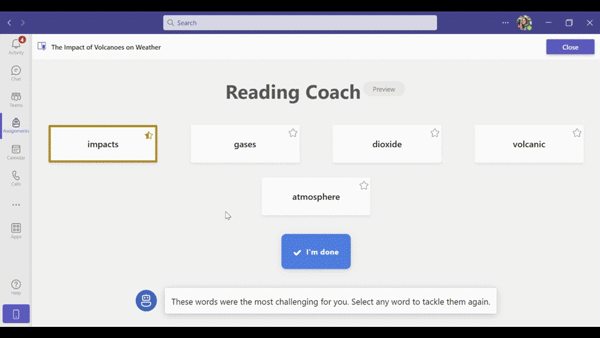
Challenge word practice in Reading Coach in Microsoft Teams for Education.
- Practice pronunciation: Pronunciation can create obstacles for MLEs. Breaking words into syllables can help students decode text and access text more effectively. Reading Coach allows students to practice words that were identified as challenging for them, even providing them with the option to learn about word meaning using a visual.
- Analyze patterns and set goals: You can view how students perform on Assignments with Reading Coach at-a-glance. Analyze phonics patterns, sight word errors, and review the auto-detected miscue analysis to inform instruction and help students set personalized reading and language development goals.
3. Immersive Reader
Immersive Reader provides students with the supports they need to access text in English, regardless of language proficiency level, and promotes educational equity in the classroom. With a range of available options, it allows students to customize their learning experience and enables you to provide a variety of language scaffolds within one solution. Learn more about how you can use Immersive Reader to ensure that all MLEs have access to grade level text.
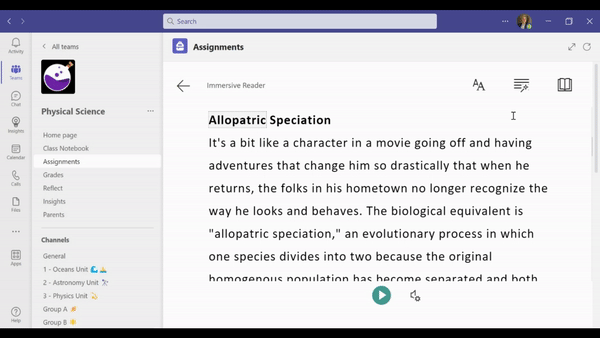
Word translation from English to Spanish and picture dictionary in Immersive Reader.
- Translate to home language: Students can translate the full text into their home language or use this translation support on a word-by-word basis. This allows students at varying degrees of English language proficiency to access the text in the language with which they are most comfortable.
- Visualize words: The Picture Dictionary tool in Immersive Reader provides a picture of the selected word, which helps MLEs to visualize the text.
- Learn parts of speech: Support understanding of sentence structure by using the Parts of Speech tool to identify and color-code nouns, verbs, adjectives, and adverbs.
- Read text aloud: MLEs can build their listening and reading skills by having text read aloud. As the text is read, the words are highlighted so that students can easily follow along and match the word to the appropriate pronunciation.
- Encourage syllabication: To support overall fluency and pronunciation as well as gain a better understanding of how affixes impact word formation and meaning, students can use the Syllables tool to segment words.
4. Education Insights
Education Insights in Teams for Education aggregates student data to provide you with quick, actionable insights at the individual or class level to amplify student language development. This saves you time, so you can focus on what’s important – your students and their academic and linguistic needs. Learn more about how you can use Education Insights to inform your instruction for MLEs.
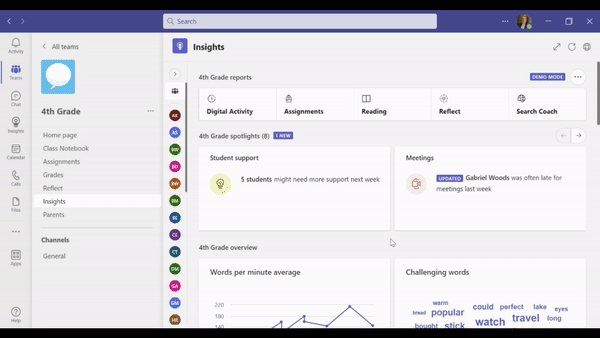
Generating a practice assignment from a challenging word cloud in Education Insights in Microsoft Teams for Education.
- Generate student practice: Develop individualized or whole class practice assignments that are tailored to the reading and language needs of MLEs in just a couple of clicks. Education Insights analyzes challenging words and phonics rules from Reading Progress and Reading Coach data to make it easier for you to look for patterns to inform instruction, create vocabulary activities, and ensure word exposure.
- Analyze progress and data: Review individual student, group, and whole class data quickly and efficiently to analyze reading progress and inform instructional decisions for MLEs.
Our Learning Accelerators offer you countless ways to support multilingual learners and scaffold instruction more efficiently. As an organization, we are committed to equity in education and deliver accessible, inclusive solutions that meet all learners’ academic, social emotional, and linguistic needs.
Learn more about Microsoft Education literacy solutions and download TESOL’s Guide to Learning Accelerators – Literacy Addition to explore activities developed to help you progress students’ English language development.

